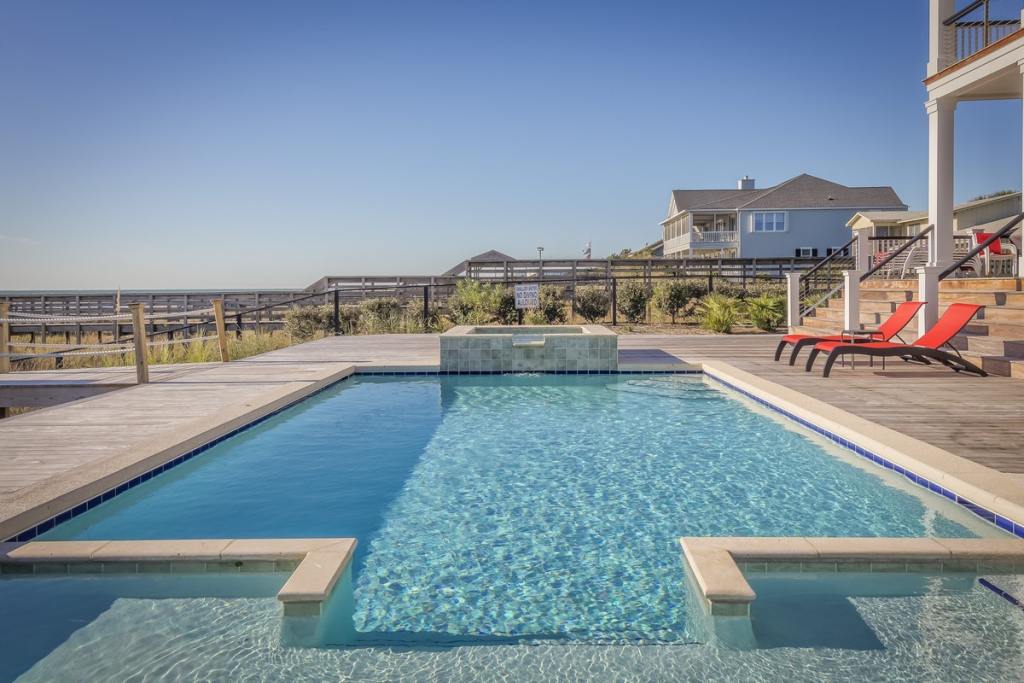Summer is in full swing. The heat is beating down, the beaches are full, and you’re more than ready to take a dip in your new backyard pool. Having a backyard pool –– an instant way to cool off in the hot summer sun –– is a wonderful luxury. But what would make a pool even more fun? A diving board.
Everyone, from kids to adults, enjoy jumping off a diving board and into the pool. Yet pool-owners can’t stick a piece of a wood at the end of the pool and call it a day. There are rules to follow, like making sure that you have the correct pool depth for a diving board.

The safe depth for a diving board
Most homes won’t be installing a high board like you might see at your local public pool. A ledge diving board, one that is low to the ground and doesn’t give much, if any, bounce, is much more popular for a residential backyard. However, even these require a safe pool depth to jump into. Thankfully, the depth isn’t that deep and is within the range of most backyard pools. You must have a pool that is at least 8 feet deep. That number might change slightly, depending on who you ask or which website you listen to. Some professionals say that 8 feet is okay for residential pools while others say it should be at least 9 feet.
Our suggestion? If you like to dive in head first, make sure the pool is 9 feet deep. If you’re jumping in any other way, then 8 feet deep is perfectly fine.
While depth is the most important thing to consider, you may also want to think about how wide your pool is. Everyone should be a safe distance away from the edges when jumping. At the very least, make sure your pool is 16 feet by 32 feet for a safe jumping width. Pick the longest side of the pool to install your diving board on so you friends and family will have the lowest chance of hitting themselves on the edges.

Other considerations
While it’s important to consider the length and width when installing a diving board, there are other other things to consider before you begin drilling.
- You might have to check with your local Homeowner’s Association to ask if you can install a diving board in the first place. Many are fickle about diving boards because of the inherent safety hazards. Make sure to understand your local rules and regulations so you don’t waste your time.
- Decorative pools can sometimes cause problems for diving boards. They’re more difficult to safely install boards on because of their unique shapes, dimensions, and materials.
- Diving boards are only meant for in-ground pools. Never, ever install a diving board on above-ground pools, because the depth is so restricted. Serious injury can occur without the proper depth, so if you only have an above-ground pool, give up your diving board dreams or build a new pool.
- Before going out to shop for a diving board, have all of your pool dimensions, specifically the length, width, and height, as well as the width of the longest side of your pool (the side you should install your diving board on). Diving boards come in different materials, lengths, and slope, so having your numbers beforehand will save you a headache.
Final thoughts
It’s absolutely true that diving boards can provide friends and family with hours of fun in your backyard. The activity takes people back to their childhood, being worry free with no care except who can make the biggest splash. Before the fun can begin, however, there are safety concerns that should be taken into account, namely the length and width of the swimming pool. The best depth for a pool is at least 8 feet deep, but preferably closer to 9 feet. If you can hit that depth with an in-ground pool, then you can install a diving board.
Editors' Recommendations
- What you need to know about light deprivation (or ‘light dep’) greenhouses and how they work
- Do you need a fence for your garden? What you need to know before deciding
- What you need to know about successfully growing summer squash in containers
- Everything you should consider before painting your pool
- What you should be cooking in your outdoor kitchen this October



